Se qui sei nuovo ISCRIVITI alle News RSS feed. Thanks for visiting!
Iain Trousdell è co-direttore dell’ Istituto per la cura dell’acqua in Inghilterra e Nuova Zelanda e direttore creativo di “Design for Life Ltd” e “Nature Intelligence Inc”. Iain è nato in Inghilterra e cresciuto in Nuova Zelanda, possedendo quel profondo interesse per l’acqua da quando la sua famiglia realizzò un viaggio lungo i mari del Sud del Pacifico e fermandosi spesso, anche per lunghi periodo lungo le spiagge che incontravano. Da ragazzo Iain Trousdell era un nuotatore agonistico a livello internazionale quando nel 1970 lavorò insieme per 3 anni a John Wilkes, uno dei più importanti visionari e inventori delle sculture Flowform. Da allora Iain Trousdell ha contribuito a sviluppare le sculture Flowform nella zona del Pacifico.
Insieme a John Wilkes, Iain Trousdell sta sviluppando mercati internazionali per diffondere e promuovere la tecnologia dei Flowform e l’arte stessa dei Flowform. Sono famose le sue conferenze internazionali sui segreti creativi dell’acqua e i modi per sviluppare tecnologie che siano realmente in armonia con la natura. Mentre prossimamente sarà produttore del film “Divine Water” insieme alla Cloud South Films. Iain Trousdell ha insegnato per 25 anni in scuole statali e Steineriane, creando sculture Flowform per oltre 400 paesaggi e progetti di sviluppo agricolo in tutto il mondo, 6 grandi sculture per l’acqua in altrettante 6 grandi capitali. Iain è anche un artista ceramista e premiato poeta.
I titoli delle sue conferenze includono:
- I segreti creativi dell’acqua.
- Curare l’acqua con tecnologie basate sull’intelligenza della natura.
- La sete mondiale è più urgente del riscaldamento globale.
- Imparare dalla natura, progettare con la natura.
- Pensiero vivo: coesistendo con la natura.
- L’Acqua: il prossimo paradigma per lo sviluppo umano
- Acqua, l’originale essere umano?
Iain Trousdell, Co-Director of the Healing Water Institute UK and NZ and Creative Director of Design for Life Ltd and Nature Intelligence Inc. He was born in England, and raised in New Zealand, Iain has had a deep interest in water since his family’s long ocean voyage to the South Pacific and much time spent on beaches here. As a teenager he was an international competitive swimmer and in the 1970s he worked for three years in the UK with John Wilkes, one of the world’s leading water visionaries and the inventor of Flowform sculptures. Since then he has developed Flowform™ eco-technology throughout the Pacific region.
With Wilkes, Iain Trousdell is now co-director of the International Healing Water Institute and creative director of Design for Life, developing global markets for their Flowform technology and art. He is in demand internationally to give talks about the creative secrets of water, and ways of developing new technology in harmony with nature. He is also producing a film called Divine Water with the award winning Cloud South Films. He has taught for 25 years in state and Steiner schools, and created Flowform designs for over 400 landscape and agricultural projects worldwide plus six major city centre water sculptures. In addition he is an award winning ceramic artist and poet.
His Talk Titles include:
- The Creative Secrets of Water.
- Healing Water with Nature Intelligence Technology.
- Global Thirst is more urgent that Global Warming.
- Learn from Nature, Design with Nature.
- Living Thinking: coexisting with nature.
- Water: the next paradigm for human development.
- Water, the original human being?
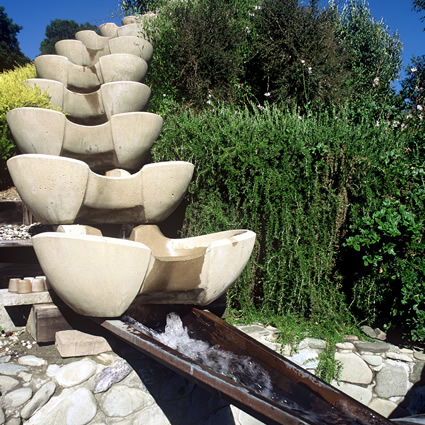
- Araceli de la Parra: Su cosa si basa la tecnologia dei Flowform?
- Araceli de la Parra: How did Flowform technology come about?
Iain Trousdell: L’acqua è un elemento stupendo, con incredibili capacità. E’ sensibile oltre la nostra immaginazione e cambia molte volte il comportamento che ci si aspetterebbe. Ha una memoria, trasmette l’intelligenza della natura e l’inquinamento umano ovunque vada e tutti gli esseri viventi dipendono da essa per la loro formazione e il continuo arricchirsi di nutrienti. Attualmente l’umanità sta distruggendo e consumando le scorte di acqua dolce sotterranea che abbiamo oltre a ridurre drammaticamente la qualità dell’acqua corrente di superficie, qualità chimica cosi come quella energetica. “La sete globale” non è un pericolo dietro l’angolo, è già qui.
La tecnologia dei Flowform è stata sviluppata attraverso lo studio dell’intelligenza della natura oltre a rappresentare esempi puri di bio-mimesi che offre un’“emozionante” modo per restituire qualità all’acqua in molte situazioni diverse. Oggi la tecnologia dei Flowform si sta sviluppando in tutto il mondo, catturando sempre maggiore attenzione come una tecnologia veramente moderna in grado di offrire l’esperienza esatta che l’umanità può lavorare in piena armonia con la natura.
Iain Trousdell: Water is a stupendous substance, with amazing capacities. It is sensitive beyond belief and breaks many expected ways of behaving. It has a memory, transmits nature’s intelligence and human pollution where ever it goes and all living things depend on it for their forms and ongoing nutrient enrichment. Presently humanity is destroying and using up the underground fresh water reserves we have, and greatly reducing the quality of our running water, both chemically and energetically. ‘Global Thirst’ is not around the corner, it is here.
Flowform technology has been developed through the study of nature’s intelligence and are pure examples of bio-mimickry, offering exciting ways of replacing water quality in many different situations. Much work like this is developing worldwide and is now catching more and more attention as a truly modern technology that offers hope that humans can work in harmony with nature.
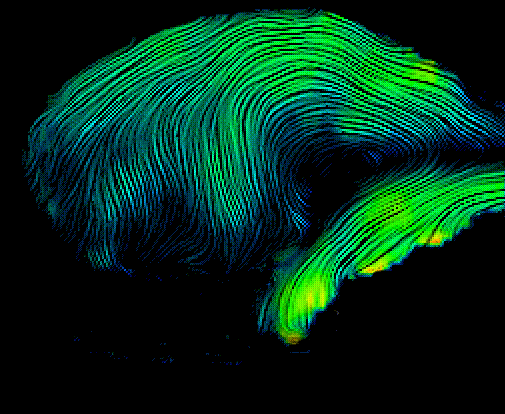
- Araceli de la Parra: Avete mai applicato le sculture di Flowforms alle macchine viventi di John Todd? Ho sempre pensato che la tecnologia dei Flowforms e le macchine viventi di Todd potrebbero combinarsi in maniera meravigliosa ed efficace.
- Araceli de la Parra: Have you ever applied Flowform sculptures to living machines? I have always thought about Flowform technology and living machines as two things that go together and could work together wonderfully and effectively.
Iain Trousdell: C’era qualcuno in Ungheria che ha sviluppato le macchine viventi per preparare le fabbriche all’integrazione dell’Ungheria all’Unione Europea, abbiamo lavorato per un breve periodo con loro ed erano interessati alla tecnologia dei Flowform come componente educativa, alla fine del processo. Ciò che essi non erano consapevoli è che speriamo nella nostra compilazione scientifica di 100 pagine riesca a fare e aiutare le persone a capire che l’acqua può essere depurata chimicamente ed organicamente mediante le radici delle piante, ma se si vuole fare dell’acqua un vero “maestro zen” in modo da catturare le radiazioni cosmiche e le informazioni della natura di estrema bassa frequenza nella sua struttura cumulativa, l’acqua deve muoversi in vortici come in un ruscello di montagna, è proprio quello che realizza una scultura Flowform. Questo è il nostro obiettivo, essere in grado di fornire il ragionamento per sviluppare questi progetti.
L’altro lato della tecnologia dei Flowform è il ritmo. Là dove c’è vita c’è anche ritmo, sia che si tratti di una pianta, di un animale o di un essere umano. Nell’occidente e ancor più in oriente si crede che il cuore sia come una pompa, quando in realtà è il movimento, il momentum biologico del liquido che lo porta in tutto il corpo a partire dai capillari. Il cuore è in realtà una manifestazione di questo movimento, nello sviluppo dell’embrione il cuore si crea a partire del movimento. John Wilkes insieme ad un medico in Inghilterra hanno sviluppato un piccolo cuore di pesce, che è stato creato a partire dal movimento, con l’aggiunta di sostanze chimiche per rendere il liquido più viscoso il cuore ha cominciato a pompare, non vi era alcun sistema nervoso che lo spingesse a farlo. Questo è quello che accade quando l’acqua si muove in maniera organizzata all’interno di un contenitore in “pelle” dove vi e solo un impulso principale, poi il ritmo si sviluppa. Nell’embrione è cosi che si forma il cuore e tutti gli organi, attraverso il liquido che si muove in maniera ritmica e metamorfica creando queste forme incredibili, conseguenza dell’intelligenza del campo quantico, solo dopo questo il cuore mantiene il ritmo. Quindi esiste tutto un cambiamento di pensiero che bisogna realizzare.
La tecnologia Flowform funziona partendo da questo pensiero e poi dal metodo scientifico che da questo si sviluppa e che si trova in natura; solo utilizzando l’intelligenza della natura interna ed esterna come quella che troviamo nei ruscelli di montagna uniti alla biologia della vita, possiamo riassumerli in una scultura elegante che è contemporaneamente tecnologia e terapia. Alcune sculture Flowform sono l’equivalente di 10 volte magari anche 20 volte la lunghezza di un ruscello di montagna, questo perché l’acqua attraversa una lemniscata ripetuta varie volte, che se estesa diventerebbe molto, molto lunga. Se avessimo una cascata di 10 sculture Flowform alta 10 metri e vi facciamo passare l’acqua, sarebbe l’equivalente di più o meno 100 o 150 metri di un ruscello di montagna … con una certa emozione, sono molto entusiasta di questo! E’ una tecnologia molto elegante e all’avanguardia.
Iain Trousdell: There was someone in Hungary who developed living machines to get factories ready to move into the European Union, we worked with him briefly and he was interested in Flowform technology as an educational component at the end of the process. What they were not aware of and we are hoping that our 100 page science compilation will help people realize is that you can clean it organically and you can clean it chemically through the plant roots but if you really want to make water a “Zen master” taking in cosmic radiation and natural information in extreme low frequency into it’s cluster structure, water has to move in vortices the way it does in a mountain stream which is what a Flowform sculpture does. That’s our aim, to be able to provide the reasoning for the development of these projects.
The other side to Flowform technology is rhythm. Wherever there is life there is rhythm, whether it is a plant, an animal or a human being. In the west and more and more in the east people think the heart is a pump, where in reality it is the movement, the biological momentum of the liquid that carries it throughout the body starting from the capillaries, and the heart is actually a manifestation of this momentum. In the embryological development the heart is created by the movement.
John Wilkes and a doctor in England have developed a tiny little fishe’s heart which was created by movement, adding chemicals to make the liquid more viscous and it started pumping, there was no nervous system making it do that. It is what happens when water moves in an organized manner within a form that has skin around it so there is only one main impulse, then the rhythm starts developing. In the embryo this is how the heart is formed, all of the organs are formed through the liquid moving in a certain rhythmical metamorphic way which gives these incredible forms that come out of the quantum field, the intelligence of the quantum field, then the heart looks after the rhythm. So, there’s a whole mind change that’s needed. Flowform technology works with these methods found in nature and also with nature’s intelligence and outer nature such as in a stream so we bring them together, the biology of life, the rejuvenation of water in a mountain stream, we bring them both together through an elegant sculpture that is also technology and therapy. Some Flowform sculptures are the equivalent we reckon of ten times maybe even twenty times it’s length in a mountain stream, because it goes through a figure 8 and gets repeated, if you unravel that, it is very, very long, so if you had a 10 meter Flowform cascade that is put together in a 3 meter stack, ten one meter Flowform sculptures and you put water through that, it’s maybe a 100 or a 150 meter mountain stream… with a heart pulse, I get excited about this! it is very elegant avantguard technology.
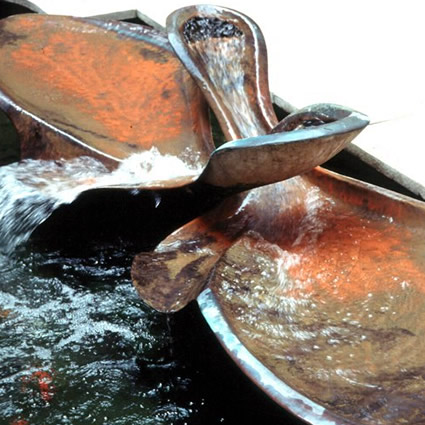
- Araceli de la Parra: Come vedi svilupparsi la tecnologia dei Flowform? A tuo parere è una tecnologia che può sostituire le attuali infrastrutture utilizzate per il trasporto dell’acqua per i vari utilizzi umani (domestico, irrigazione, industria)? Come credi che dovremmo in questo caso manipolare l’acqua e quanto la dovremmo manipolarla?
- Araceli de la Parra: How do you see Flowform technology evolving? Do you see it as replacing current infrastructure used to carry water for our different purposes (household, irrigation, industrial)? How do you think we should manipulate water and how much should we manipulate it?
Iain Trousdell: Si tratta di una questione centrale, ci sono molte persone che ci stanno pensando ovviamente. Per il momento l’umanità utilizza intorno al 60 o 65% di acqua dolce da fonti sorgive e nei prossimi 25 o 30 anni questa cifra salirà al 90%. L’acqua è un elemento libero che sta là fuori nel mondo ripristinandosi e creandosi in condizioni ideali e perfette, organicamente, chimicamente ed energeticamente autonome per l’uso della natura. Questo è stato per eoni e adesso dopo la nostra rivoluzione industriale improvvisamente ci rendiamo conto che l’acqua non è una risorsa infinita, che l’acqua dolce facilmente utilizzabile è soltanto l’1% dell’acqua totale sul pianeta, questo vuol dire che più o meno 11000 miliardi di litri ma che comunque non è abbastanza per tutti gli utilizzi che ne facciamo. Soltanto l’agricoltura ne utilizza il 65%, l’uso domestico risulta essere l’ 8% e il restante nell’industria. Non ci abbiamo mai nemmeno pensato fino a poco tempo fa e stiamo ancora buttando 400 milioni di tonnellate di rifiuti tossici invariati nelle acque dolci all’anno e soltanto il 30% delle acque che utilizza l’uomo vengono depurate. Nelle città gira e rigira l’acqua passa attraverso forse 4 o 6 reni prima di essere rilasciata nella natura, quindi i chimici possono dire “quest’acqua va bene per bere” quando esce dal rubinetto ma sotto questa pressione all’acqua si toglie vitalità e il campo quantico viene schiacciato. E’ come il cibo d’asporto che non fa bene a nessuno.
Noi obblighiamo ad andare attraverso i nostri tubi, non credo quindi che le sculture Flowform possano sostituire questi tubi, credo invece che Schauberger abbia già evoluto tubi vorticali che sono i veramente necessari. Esistono anche persone che stanno sviluppando diverse leghe per tubazioni che attirano gli ioni e li trasmettono all’acqua. Soprattutto esistono persone con idee meravigliose che stanno lavorando separatamente, infatti vorremo far parte di un gruppo che iniziasse a coordinare queste idee. Per quanto riguarda il sollevamento di acqua, vi sono alcune pompe interessanti in fase di sviluppo, stiamo lavorando su una pompa ritmica e anche pompe che sollevano l’acqua attraverso superfici di curve di traiettoria.
Iain Trousdell: It’s a central question, there are many people who are thinking about it obviously and at the moment humanity is capturing 60% or 65% of fresh water original sources and in the next 25 to 30 years it will rise to 90%. Water is this free being that is out there in the world restoring itself, making itself in world class perfect conditions, organically, chemically, energetically for use by nature and it’s done this for eons and now with our industrial revolution we suddenly realize that this is not an unending resource. That fresh water is only .1% of all the water on the planet, it is still 11,000 billion liters but it is not enough water for all of the uses we make for it, agriculture alone uses 65% of all the fresh water, domestic use is only 8% of the water and the rest of it is industry, so what do we do with this? We haven’t even thought about it until recently and still we’re putting 400 million cubic tons of unchanged toxic wastes into fresh water every year and only 30% of the water that humans capture gets any cleaning, in cities it goes round and round in circles it might go through 5 or 6 kidneys before it goes back out into nature, so chemists may say “well, this is ok to drink” when it is coming out of the tap but it is being under all this pressure which drives out the life from water, the quantum field gets squashed out. It’s like take away food that’s no good for anybody. So we run it through our factories, we run it through our pipes, I don’t think Flowform sculptures will substitute piping, I think Schauberger has already evolved vortical piping which is what’s needed, there are also people who are developing different alloys for piping that attract ions and pass them on into the water. There are many people with wonderful ideas working separately and we’d like to be part of a group that starts to coordinate these ideas. With regards to the lifting of water, there are some exciting pumps being developed, we are working on a rhythmical pump and also pumps that lift water along path curve surfaces
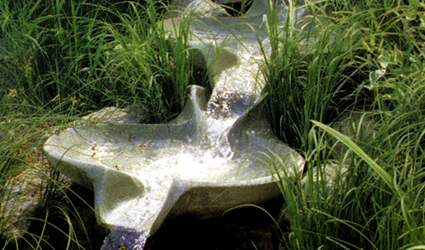
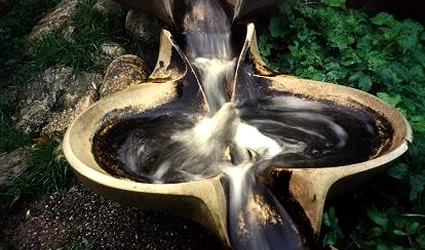
- Araceli de la Parra: Ci potresti raccontare di più su queste curve di traiettoria come metodo di progettazione per le sculture Flowform?
- Araceli de la Parra: Could you tell us more about path curves and this method of designing Flowform sculptures?
Iain Trousdell: George Adams e Theodor Schwenk istituirono l’Institute of flowing sciences nel 1950, George Adams sviluppava le tecnologie e Schwenk avrebbe valutato l’efficacia di queste tecnologie, attraverso i metodi da lui evoluti (esperimento di scatto alla goccia, ecc.) Purtroppo Gorge Adams (con il quale John Wilkes ha lavorato) morì nel 1963, aveva sviluppato queste matematiche su suggerimento di Rudolph Steiner e Burton Russel guardando le superfici viventi come uova, uccelli, processi embrionali, forme delle foglie, ecc. e tutte queste hanno matematiche complesse che nascono come lui le chiamava in “controspazio” che ora chiaramente è il campo quantico. Stava realizzando questi studi 60 anni fa, prima dei computer, era un genio che in un certo senso ci si dimenticò ma sviluppò le matematiche più eccitanti. Lawrence Edwards riprese il suo lavoro e studio la matematica nei liquidi all’interno delle forme viventi, uova, uccelli, alberi e fu capace di dimostrare che quando queste matematiche della curva di traiettoria erano perfette l’organismo in se stesso era nel suo stato più sano.
Il lavoro di George Adams con John Wilkes diventò successivamente un altro ramo delle matematiche di curve di traiettoria specializzato nel creare superfici attraverso le quali l’acqua scorresse per incrementare la capacita dell’acqua a favorire la vita. E proprio ora stiamo incorporando le curve di traiettoria nella tecnologia dei Flowform. La maggior parte dell’eco-tecnologia Flowform fino adesso è stata empirica e sviluppata attraverso la conoscenza personale sul movimento dell’acqua che spesso è approssimativo rispetto alle matematiche delle curve di traiettoria.
Iain Trousdell: George Adams and Theodor Schwenk set up the institute of flowing sciences in 1950, George Adams would develop the technology and Schwenk would assess the effectiveness of that technology through the methods he had evolved (drop picture experiment and the like). Unfortunately George Adams (whom John Wilkes worked with) died in 1963, he had developed these mathematics on the suggestion of Rudolph Steiner and Burton Russell looking at living surfaces in eggs, birds, embryological processes, leaf shapes etc and all of these have highly complex mathematics that are born out of which he called counterspace which is now of course the quantum field. He was working on this 60 years ago, before the computer, he was a genius who in a sense is being forgotten but he developed the most exciting mathematics. Lawrence Edwards picked up on his work and he studied the mathematics of liquid within living forms, eggs, birds, trees and he was able to show that when the path curve mathematics were perfect the organism itself was at it’s most healthy state.
George Adam’s work with John Wilkes was another branch of path curve mathematics which was creating surfaces over which water would flow to increase the capacity of water to support life, we are incorporating path curves into Flowform technology. Most of the Flowform eco-technology has been empirical through personal knowledge of water movement which sometimes approximates path curve mathematics.
- Araceli de la Parra: Avete notato una differenza fra l’approccio empirico e quello matematico nel progettare sculture Flowform?
- Araceli de la Parra: Have you seen a change between empirical versus mathematical pathcurve approach to designing Flowform sculptures?
Iain Trousdell: Purtroppo non abbiamo ancora potuto fare una ricerca su questo argomento, l’Istituto per la cura dell’acqua non è ancora completamente finanziato e questo è un settore sul quale vorremo fare ricerca. Abbiamo file di persone che vogliono lavorare con noi, abbiamo un ricercatore dedicato, uno scienziato in fisica e biologia, Nick Thomas per le curve di traiettoria in Inghilterra. L’Istituto in Nuova Zelanda lavora molto nel settore dell’agricoltura e apriremo presto un ufficio anche negli Stati Uniti dedicato all’educazione e stiamo lavorando su un documentario intitolato “Acqua Divina” grazie ad un rinominato gruppo di studiosi di spicco.
La gente deve capire che se muoviamo l’acqua lungo linee dritte, essa perde la sua capacita di favorire la vita, solo quando si prenderà seriamente questa questione (ovviamente è un grande problema educativo, ma ora abbiamo la mentalità e si può già cominciare questo lavoro) le persone si accorgeranno che l’acqua che esce dal rubinetto può si bagnare la loro pelle ma non sta facendo molto di più per loro. Quando questo lato energetico della qualità dell’acqua diventerà noto e apprezzato, inizieremo a mettere da parte del denaro per sviluppare tecnologie che supportino l’acqua e in questo senso credo che la tecnologia Flowform diventerà quella principale … mi piacerebbe vedere sculture Flowform in tutte le grondaie, canali di irrigazioni, sulle strade, ovunque …
Iain Trousdell: Unfortunately we have not been able to test that yet, the Healing Water Institute is not yet fully funded and this is one of the things that we’d like to research. We have people lined up who want to work, we have a very dedicated researcher, a scientist in physics and biology, there is Nick Thomas on path curves working in England. Healing water Institute in New Zealand works a lot with agriculture, we will soon open one in the United States that will be centered on education and we are working on a documentary which will be called “Divine Water” with an award winning film crew and top interviews.
People need to realize that if we move water in straight lines and take away all of it’s support it looses it’s capacity to support life, when they take this seriously (of course this is a big educational issue but now we have the mindset and can start educating) people will realize the water coming out of their tap might be wet but it is not doing much for them. When this energetic side of water quality becomes well known and appreciated, we will start putting aside money to develop technologies that support water in this sense, I believe Flowform technology is the main one, I’d like to see Flowform sculptures in all the guttering, irrigation channels, on roads …
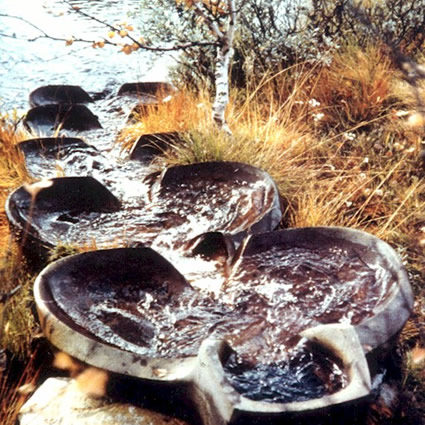
- Araceli de la Parra: A tuo parere è possibile integrare completamente la tecnologia Flowform al paesaggio? O deve per forza essere un “contenitore” uscito da uno stampo?
- Araceli de la Parra: Could Flowform technology become part of the landscape? Or does it need to be a cast piece container?
Iain Trousdell: Si potrebbero progettare delle sculture Flowform con i bulldozer come controllo per le inondazioni dei fiumi, ma per la natura dell’acqua avranno bisogno di un rivestimento di qualche tipo. Le superfici sono difficili da controllare, è un po come creare uno strumento musicale e se vogliamo che la scultura Flowform sia efficace queste superfici devono essere controllate. Ci vuole molto tempo per progettare una scultura Flowform e ad oggi c’è soltanto una manciata di persone che possa farlo correttamente.
Iain Trousdell: Well, we could design Flowform sculptures with bulldozers as flood control for rivers but because of the nature of water they will need lining in some way or another, the surfaces are difficult to control, it’s a bit like creating an instrument and if you want the Flowform sculpture to be effective, it takes a long time to design one and there’s only a handful of people who are able to do it properly.
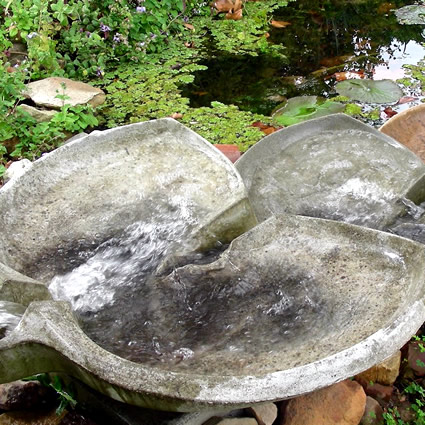
- Araceli de la Parra: Le idee di Viktor Schauberger per i canali in cui vengono inseriti dei piccoli corpi in luoghi strategici per avere il movimento desiderato nel acqua, secondo te è realmente applicabile?
- Araceli de la Parra: What about Viktor Schauberger’s ideas for canals in which stones or ‘bumps’ were set strategically to create the desired movement in water?
Iain Trousdell: Qui in Nuova Zelanda abbiamo ricreato effettivamente quest’idea con il finanziamento del governo verso la meta del 1990 insieme a uno dei più importanti idrologi della Nuova Zelanda con cui abbiamo realizzato un modello in scala 1:25. Schauberger chiama questi corpi, “corpi energetici” e sono quasi come una scultura Flowform tagliata per metà e mettendo quei due lati insieme verticalmente opposti uno all’altro. Queste forme sono molto particolari e abbiamo lavorato posizionandole cambiando cosi il comportamento del fiume in maniera radicale. I fiumi “depressi” possiedono un flusso centrale lento e più veloce ai bordi esterni. I fiumi sani invece hanno il flusso più veloce e profondo al centro e sabbia sulla riva, noi con questi corpi energetici abbiamo restituito il flusso naturale del fiume in modo da prevenire le inondazioni sulle strade e nei centri abitati.
Iain Trousdell: Here in New Zealand we’ve actually recreated those with government funding in the mid 1990’s with one of New Zealand’s leading hydrologists, we did a 1:25 scale model. Schauberger calls these energy bodies and they’re really like creating a Flowform sculpture, splitting it down the middle and putting those two sides up vertically, those surfaces are very particular and we’ve worked on those positioning them opposite each other like twins in the center of the river channel bringing about a remarkable change in the behaviour of the river. Lower rivers are depressed and they’ve inverted the central flow so that the faster flow is on the outside and slower in the middle. Normally rivers should have deeper/faster flow in the middle and there’s sand on the banks and so these energy bodies we inserted returned the natural flow to the river, preventing floods onto the roads.
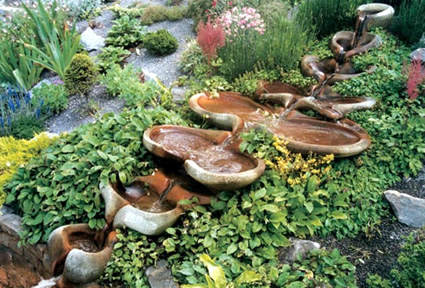
- Araceli de la Parra: Quali sono i materiali utilizzati per le tecnologie Flowform? Quali sono le varie alternative? Il vetro ad esempio potrebbe essere un’alternativa valida?
- Araceli de la Parra: Materials being used for Flowform technologies? What are the alternatives? Could glass be a valid alternative?
Iain Trousdell: E’ possibile realizzare sculture Flowform in qualsiasi materiale, personalmente non ho nulla contro la plastica, ci sono persone che stanno stampando libri su un tipo di plastica perché la ritengono un materiale migliore per l’ambiente (vedi “Dalla culla alla culla” MBDC). Si tratta di una formula complicata quella della scelta dei materiali, è necessario tenere conto anche dell’impronta energetica del materiale che si andrà ad utilizzare nella struttura per l’acqua. Con il nostro Istituto ci sarebbero da compiere numerose ricerche naturalmente in questo campo.
Questi sono i materiali che abbiamo utilizzato nelle sculture Flowform:
- Calcestruzzo: abbiamo trovato che è la peggiore alternativa, con elevate emissioni di CO2 e diverse problematiche riguardo la durabilità oltre alla pesantezza del materiale che richiede un’elevata quantità di energia per il trasporto e l’installazione.
- Resine: Questo è il materiale che utilizziamo più spesso, filtrando i fumi durante la reazione chimica, le sculture in questo materiale sono leggere, resistenti e di facile installazione.
- Ceramica: Lascia l’acqua con un gusto dolce e segoso, può essere duratura se gestita correttamente.
Design For Life ha speso 7 anni per cercare la soluzione di produrre in massa le sculture Flowform e nel processo abbiamo inventato un metodo che utilizza i poliesteri e vinili ma non molta sabbia naturale siamo in grado di produrre sculture Flowform grandi in 3 ore con questo metodo. Il vetro è stato utilizzato e abbiamo persone a New York che sono interessate a creare sculture Flowform in vetro riciclato. Stiamo indagando sulle resine biologiche che derivano da olio di frutta a guscio e dai semi, questo chiaramente ha lo svantaggio di utilizzare suolo che potrebbe essere utilizzato per coltivare cibo per uso industriale, ma stiamo valutando l’opzione.
Iain Trousdell: You can make Flowform sculptures out of any material, I personally have nothing against plastic, there are people who are making books out of plastic (cradle to cradle MBDC). It is a complicated formula that of choosing a material, you also need to take into account the energetic signature of the material that goes into cluster structures of water, there are a lot of things we want to research in this area.
We’ve experimented with the following:
- Concrete: which we’ve found is the worst alternative with high co2 emissions and durability issues, plus the heaviness of the material which makes for energy intensive transport and set up.
- Resins: which we use most often, we filter out fumes during curation, they are lightweight, durable and easy setup.
- Ceramics: leave water with a sweet silky taste, can be durable if handled properly.
Design For Life spent 7 years solving how to mass produce Flowform sculptures and during this time we invented a process that does use polyesters and vinyls but not a lot and natural sand, we can produce large Flowform sculptures in 3 hours with this method. Glass has been used and we have people in NY who are interested in using recycled glass to create Flowform sculptures. We are investigating bioresins which are resins that are made from oil in nuts and seeds, this of course has the drawback of utilizing soil that could be used to provide food for industrial use, but we are evaluating the option.
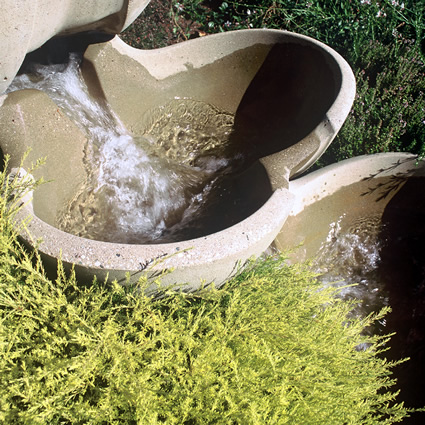
[ Links utili e approfondimenti ]





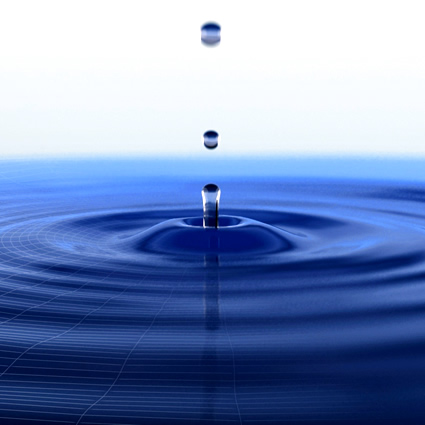






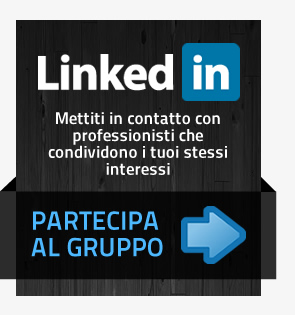
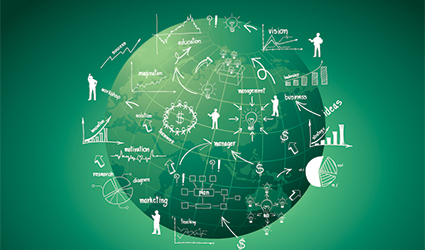













Nessun commento
Attualmente non ci sono commenti per Flowform technology: Acqua Viva. Con Iain Trousdell alla scoperta dell’Intelligenza della Natura. Sculture Flowform, come rivitalizzare l’Acqua con il giusto ritmo. Perchè non ne aggiungi uno?